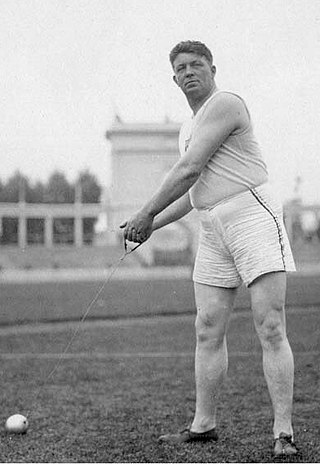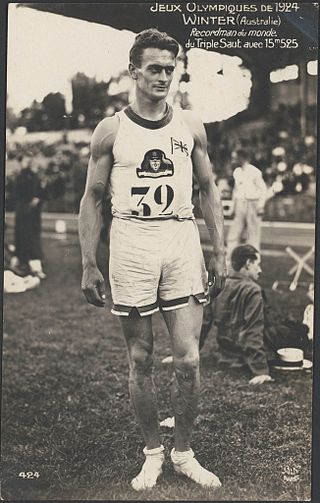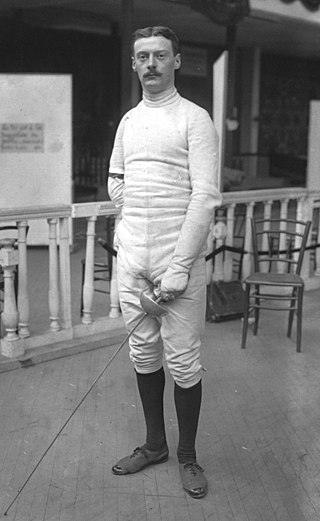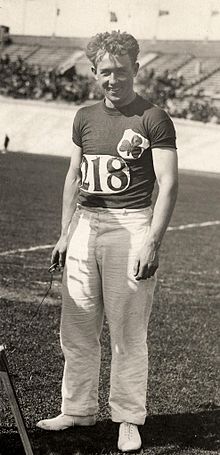
The men's hammer throw was one of four men's throwing events on the Athletics at the 1964 Summer Olympics program in Tokyo. It was held on 17 October and 18 October 1964, with the qualification on the first day and the final the next. 25 athletes from 14 nations entered, with 1 not starting in the qualification round. The maximum number of athletes per nation had been set at 3 since the 1930 Olympic Congress. The event was won by Romuald Klim of the Soviet Union, the nation's second consecutive victory in the men's hammer throw. Gyula Zsivótzky of Hungary repeated as silver medalist, the fifth man to win multiple medals in the event. Uwe Beyer took bronze, the first medal for the United Team of Germany and the first medal for any German hammer thrower since 1952.

The men's hammer throw was an event at the 1956 Summer Olympics in Melbourne, Australia. The qualifying round and the final both were held on Saturday November 24, 1956. There were 22 competitors from 14 nations. The maximum number of athletes per nation had been set at 3 since the 1930 Olympic Congress. The event was won by American Hal Connolly, the nation's first victory in the event since 1924 and seventh overall. Mikhail Krivonosov (silver) and Anatoli Samotsvetov (bronze) earned the Soviet Union's first medals in the event.

The men's hammer throw was an event at the 1996 Summer Olympics in Atlanta, Georgia. There were 37 competitors from 22 nations, with twelve athletes reaching the final. The maximum number of athletes per nation had been set at 3 since the 1930 Olympic Congress. The eight highest-ranked competitors after three rounds qualified for the final three throws to decide the medals. The qualification mark was set at 76.50 metres. The event was won by Balázs Kiss of Hungary, the nation's first victory in the men's hammer throw since 1968 and fourth overall. Lance Deal earned the United States' first medal in the event since 1956 with his silver. Oleksandr Krykun's bronze gave Ukraine a medal in its debut as an independent nation.

The men's hammer throw event was part of the track and field athletics programme at the 1920 Summer Olympics. The competition was held on Wednesday, August 18, 1920. 12 throwers from 5 nations competed; four from Sweden, four from the United States, two from Canada, one from Great Britain, and one from Finland. No nation had more than 4 athletes, suggesting the limit had been reduced from the 12 maximum in force in 1908 and 1912. The event was won by Patrick Ryan of the United States, the nation's fifth consecutive victory in the event. Carl Johan Lind took silver, earning Sweden's first medal in the hammer throw. Another American, Basil Bennett, earned bronze.

The men's hammer throw event was part of the track and field athletics programme at the 1924 Summer Olympics. The competition was held on Thursday, July 10, 1924. 15 hammer throwers from ten nations competed. The maximum number of athletes per nation was 4. The event was won by Fred Tootell of the United States, the nation's sixth consecutive victory in the event; the Americans would not win again until 1956. Tootell was the first of the winners to have been born in the United States; the previous winners had all been Irish-American. Fellow American Matt McGrath, the 1908 silver medalist and 1912 champion, took silver once again; he was the second man to earn three medals in the hammer throw. Malcolm Nokes earned Great Britain's first medal in the event with his bronze.

The men's shot put event was part of the track and field athletics programme at the 1924 Summer Olympics. The competition was held on Tuesday, July 8, 1924. 28 shot putters from 15 nations competed. The maximum number of athletes per nation was 4. The event was won by Bud Houser of the United States, the nation's sixth victory in the men's shot put. Glenn Hartranft took silver and Ralph Hills took bronze to complete the Americans' fourth medal sweep in the event.

The men's triple jump event was part of the track and field athletics programme at the 1924 Summer Olympics. The competition was held on Saturday, July 12, 1924. Twenty triple jumpers from twelve nations competed. The maximum number of athletes per nation was 4. The event was won by Nick Winter of Australia, the nation winning gold in its debut in the event. Argentina also medaled in its first triple jump appearance, with Luis Brunetto taking silver. Defending champion Vilho Tuulos of Finland took bronze, the fourth man to win a second medal in the event.

The men's hammer throw event at the 1980 Summer Olympics in Moscow, Soviet Union had an entry list of 17 competitors from 13 nations, with one qualifying group before the final (12) took place on 31 July 1980. Top 12 and ties and all those reaching 72.00 metres advanced to the final. The maximum number of athletes per nation had been set at 3 since the 1930 Olympic Congress. The event was won by Yuriy Sedykh of the Soviet Union, repeating as Olympic champion. He was the eighth man to win multiple medals in the event and third to have at least two gold medals. Just as in 1976, Sedykh led the Soviet team to a medal sweep, with Sergey Litvinov taking silver and Jüri Tamm bronze. The gold medal was the Soviet Union's third consecutive and fifth overall in the men's hammer throw, second all-time to the United States's seven.

The men's hammer throw at the 2000 Summer Olympics as part of the athletics program was held at the ANZ Stadium on Saturday, 23 September and Sunday, 24 September. There were 44 competitors from 24 nations. The event was won by Szymon Ziółkowski of Poland, the nation's first victory in the event and first medal of any color in the men's hammer throw since 1960. Silver went to Nicola Vizzoni, the first medal winner in the event for Italy. Igor Astapkovich, who had won a silver medal on the Unified Team in 1992, took bronze for the first medal credited to Belarus in the event. Astapkovich was the 11th man to win multiple medals in the hammer throw.

The men's 110 metres hurdles event at the 1928 Olympic Games took place between July 31 & August 1. Forty-one athletes from 24 nations competed. The maximum number of athletes per nation was 4. The event was won by Sydney Atkinson of South Africa, the nation's first title in the 110 metres hurdles; Atkinson became the first man to win two medals in the event. It was only the second time the United States had not won the event; as in 1920, the Americans took silver and bronze.

The men's hammer throw event at the 1932 Olympic Games took place August 1. There were 14 competitors from 9 nations. The 1930 Olympic Congress in Berlin had reduced the limit from 4 athletes per NOC to 3 athletes. The event was won by Pat O'Callaghan of Ireland, repeating as Olympic champion. O'Callaghan was the third man to win multiple hammer throw medals and the second to repeat as gold medalist. His victory also made 7 of the first 8 Olympic hammer throw competitions won by Irish-born athletes; in addition to O'Callaghan's two victories for Ireland, five of the United States' wins were by Irish-American throwers. Ville Pörhölä took silver for Finland's first medal in the event. Peter Zaremba extended the United States' medal streak to eight Games with his bronze.

The men's épée was one of seven fencing events on the Fencing at the 1928 Summer Olympics programme. It was the seventh appearance of the event. The competition was held from 6 August 1928 to 7 August 1928. 59 fencers from 22 nations competed. Each nation could have up to three fencers. The event was won by Lucien Gaudin of France, the nation's third victory in the individual men's épée—taking sole possession of most among nations above Cuba and Belgium, each at two. Gaudin was the second man to win both the foil and épée events at a single Games. It was the third consecutive Games at which France reached the podium in the event. Two Frenchman had reached the head-to-head final; Gaudin won over Georges Buchard, who received silver. Bronze in 1928 went to American George Calnan, the nation's first medal in the event.

The men's hammer throw event was part of the track and field athletics programme at the 1936 Summer Olympics. The competition took place on August 3, 1936, with 27 competitors from 16 nations. The maximum number of athletes per nation had been set at 3 since the 1930 Olympic Congress. The final was won by Karl Hein of Germany. The silver medal went to Erwin Blask, also of Germany. They were the first medals for Germany in the event; Germany was also the first country other than the United States to have two medalists in the event in the same Games. Fred Warngård of Sweden took bronze. The United States' eight-Games medal streak in the hammer throw was snapped, with the Americans' best result being William Rowe's fifth place.

The men's 400 metres hurdles event at the 1932 Olympic Games took place on July 31 and August 1 at the Los Angeles Memorial Coliseum. There were 18 competitors from 13 nations. The 1930 Olympic Congress in Berlin had reduced the limit from 4 athletes per NOC to 3 athletes. The event was won by Bob Tisdall of Ireland, the nation's first medal in the event in its 400 metres hurdles debut. The United States took silver and bronze, extending its streak of taking at least silver in all 7 appearances of the event to that point. Taylor became the first man to earn three medals in the event, adding to his 1924 gold and 1928 bronze. Defending champion David Burghley of Great Britain finished fourth.

The men's discus throw throwing event at the 1960 Summer Olympics took place on September 6 & September 7. Thirty-five athletes from 22 nations competed. The maximum number of athletes per nation had been set at 3 since the 1930 Olympic Congress. The event was won by Al Oerter of the United States, the nation's third consecutive and 10th overall victory in the men's discus throw. It was Oerter's second gold medal in the event; he would go on to win four. Oerter was the sixth man to win two medals in the event, and the third to win two gold medals. The United States earned its second consecutive and third overall medal sweep in the event, as Rink Babka took silver and Dick Cochran bronze.

The men's hammer throw at the 1960 Summer Olympics took place on September 2 (qualifying) and September 3 (final) at the Stadio Olimpico. The qualifying standards for the 1960 event were 60 m. There were 28 competitors from 18 nations. The maximum number of athletes per nation had been set at 3 since the 1930 Olympic Congress. The event was won by Vasily Rudenkov of the Soviet Union, the nation's first victory in the event. Gyula Zsivótzky took silver, Hungary's fourth medal in the last four Games in the men's hammer throw. Tadeusz Rut's bronze was Poland's first medal in the event.

The men's hammer throw field event at the 1972 Summer Olympics took place on September 4 & 7. There were 31 competitors from 17 nations. The maximum number of athletes per nation had been set at 3 since the 1930 Olympic Congress. The event was won by Anatoliy Bondarchuk of the Soviet Union, the nation's third victory in the men's hammer throw. Fellow Soviet Vasiliy Khmelevskiy took bronze. Silver went to Jochen Sachse of East Germany, the nation's first medal in the event. The Soviet Union's medal streak in the event extended to five Games, while Hungary's ended after three Games.

The men's hammer throw event at the 1952 Summer Olympics took place on 24 July at the Helsinki Olympic Stadium. There were 33 competitors from 18 nations. The maximum number of athletes per nation had been set at 3 since the 1930 Olympic Congress. The event was won by József Csermák of Hungary, the nation's second consecutive victory in the event. Imre Németh, who had won four years earlier, took bronze; he was the fourth man to win multiple medals in the event. Silver went to Karl Storch of Germany.

The men's hammer throw competition at the 1968 Summer Olympics in Mexico City, Mexico took place on October 16–17. There were 22 competitors from 12 nations. The maximum number of athletes per nation had been set at 3 since the 1930 Olympic Congress. The event was won by Gyula Zsivótzky of Hungary, who had taken silver in both 1960 and 1964; he was the third man to win three medals in the hammer throw (after John Flanagan and Matt McGrath. Zsivótzky defeated defending champion Romuald Klim of the Soviet Union, who earned silver this time to become the sixth man to win multiple medals in the event. Bronze went to Lázár Lovász of Hungary.

The men's hammer throw competition at the 1976 Summer Olympics in Montreal, Quebec, Canada took place on 26–28 July. There were 20 competitors from 13 nations. The maximum number of athletes per nation had been set at 3 since the 1930 Olympic Congress. The event was won by Yuriy Sedykh of the Soviet Union, the nation's second consecutive and fourth overall victory in the men's hammer throw. The Soviets swept the medals, with Aleksey Spiridonov taking silver and defending champion Anatoliy Bondarchuk earning bronze. It was the third medal sweep in the men's hammer throw. Bondarchuk was the seventh man to win multiple medals in the event.



















